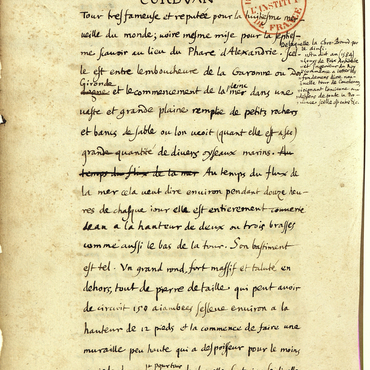
- Home
- A Renaissance monument
- A royal tower
- The memory of Alexandria
When Louis de Foix (ca. 1535–ca. 1602), engineer to Henri III, was tasked in 1584 with building a monument in the Gironde Estuary, the Pharos of Alexandria was only a distant memory. The mythical tower of Antiquity stood more than one hundred metres high, and bore the name of the island on which it was built starting in 297 BCE: Pharos. It served as a guide for sailors ; above all, however, it was a monument to the glory of the Ptolemaic Dynasty, and it was a focal point of the sciences and the arts of its time. After its disappearance in the early fifteenth century, the Pharos became a myth perpetuated by travellers and artists. Fantastical images of it persisted until the scientific efforts of archaeologists, who are continually searching for underwater vestiges of this wonder of the world. Engravings from the sixteenth century depict it as a sort of tower of Babel, completely unrelated to information contained in Arab manuscripts. Nevertheless, there is a close connection between Cordouan and Alexandria, the story of which was known to Louis de Foix. De Foix persuaded the king that his tower, which revived the memory of its Alexandrian ancestor, would be a monument that would perpetuate the king's memory down through the ages. The architect obtained for himself the same privilege granted to Sostratus of Cnidus, the architect of the Pharos if Alexandria: that his memory would be celebrated in the form of a bust and a poem. From this viewpoint, Cordouan acts as a sort of "missing link" between the ruined lighthouses of Antiquity and the modern beacons that began to appear in a century after Louis de Foix began his work.


